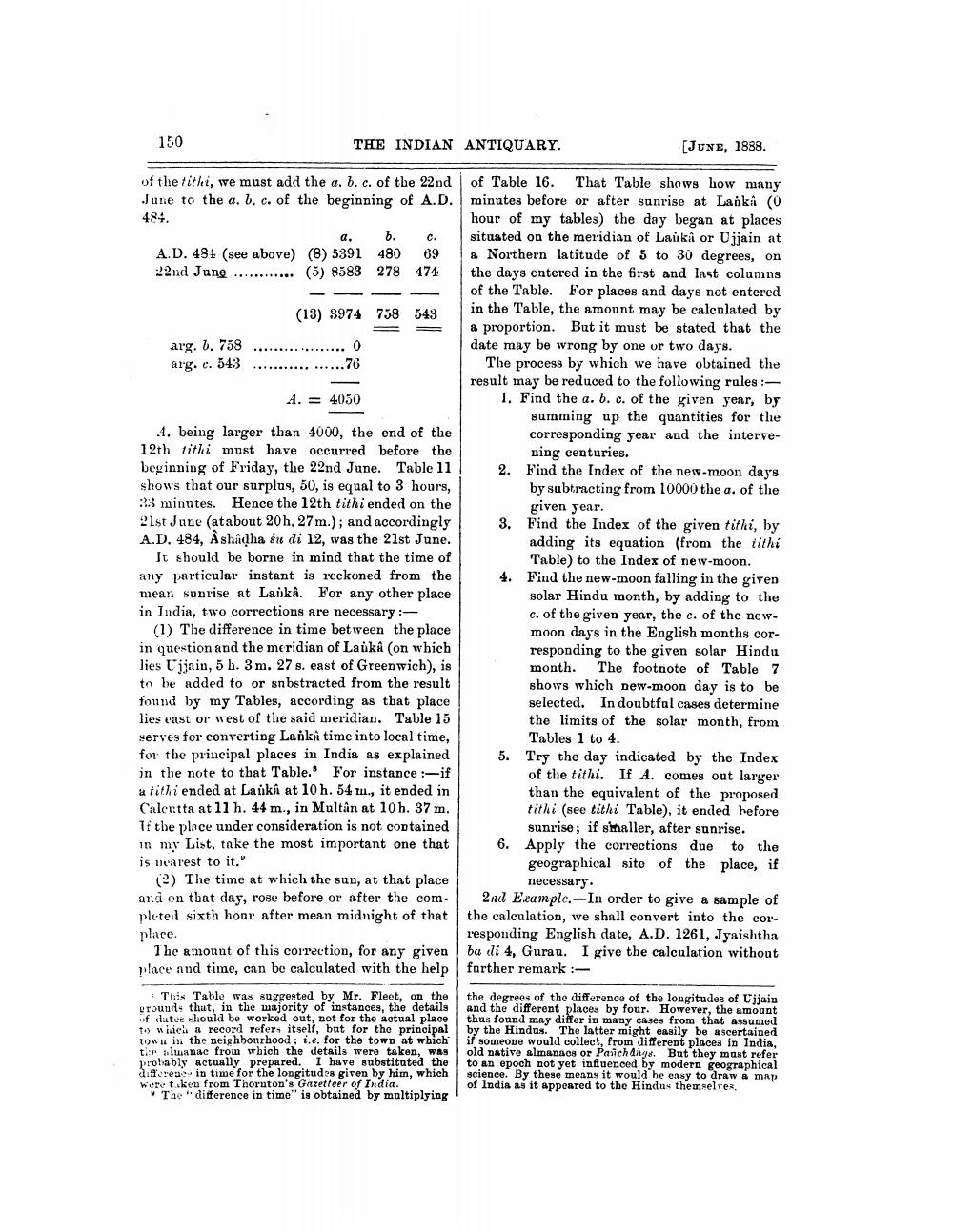________________
150
THE INDIAN ANTIQUARY.
(June, 1888.
of the tithi, we must add the a. b. c. of the 22nd of Table 16. That Table shows how many June to the a. 1. c. of the beginning of A.D. minutes before or after sunrise at Lanka (0 484.
hour of my tables) the day began at places
a. 6. c. situated on the meridian of Lauka or Ujjain at A.D. 481 (see above) (8) 5391 480 69 & Northern latitude of 5 to 30 degrees, on - 2 nd Jung ............ (5) 8583 278 474 the days entered in the first and last columns
of the Table. For places and days not entered (18) 3974 758 543
in the Table, the amount may be calculated by
a proportion. But it must be stated that the arg. 6. 758 .........
date may be wrong by one or two days. arg. c. 543 ................. 76
The process by which we have obtained the
result may be reduced to the following rules :A. = 4050
I. Find the a. b. c. of the given year, by
summing up the quantities for the .4. being larger than 4000, the end of the
corresponding year and the interve12th tithi must have occurred before the
ning centuries. beginning of Friday, the 22nd June. Table 11
Find the Index of the new-moon days shows that our surplus, 50, is equal to 3 hours,
by subtracting from 10000 the a. of the 33 minutes. Hence the 12th tithi ended on the
given year. 21st June (at about 20h. 27m.); and accordingly 3. Find the Index of the given tithi, by A.D. 484, Ashadha su di 12, was the 21st June.
adding its equation (from the tithi It should be borne in mind that the time of
Table) to the Index of new-moon. any particular instant is reckoned from the
Find the new-moon falling in the given mean sunrise at Laukå. For any other place
solar Hindu month, by adding to the in India, two corrections are necessary :
c. of the given year, the c. of the new(1) The difference in time between the place
moon days in the English months corin question and the meridian of La úků (on which
responding to the given solar Hindu lies Ujjain, 5 b. 3 m. 27 s. east of Greenwich), is
month. The footnote of Table 7 to be added to or snbstracted from the result
shows which new-moon day is to be found by my Tables, according as that place
selected. In doubtfal cases determine lies vast or west of the said meridian. Table 15
the limits of the solar month, from serves for converting Lanka time into local time,
Tables 1 to 4. for the principal places in India as explained
Try the day indicated by the Index in the note to that Table. For instance :-if
of the tithi. If A. comes out larger a tithi ended at Lauki at 10 h. 54 m., it ended in
than the equivalent of the proposed Calcutta at 11 h. 44 m., in Multân at 10h. 37 m.
tithi (see tithi Table), it ended hefore If the place under consideration is not contained
sunrise; if smaller, after sunrise. in my List, take the most important one that 6. Apply the corrections due to the is nearest to it."
geographical site of the place, if e) The time at which the sun, at that place
necessary. and on tbat day, rose before or after the com- 2nd Example.-In order to give a sample of pleted sixth hour after mean midnight of that the calculation, we shall convert into the corplace
responding English date, A.D. 1261, Jyaishtha 1 he amount of this correction, for any given ba di 4, Gurau. I give the calculation without place and time, can be calculated with the help farther remark:
This Table was suggested by Mr. Fleet, on the grounds thut, in the majority of instances, the details of later should be worked out, not for the actual place to which a record refers itself, but for the principal town in the neighbourhood: i.e. for the town at which ti lanac from which the details were taken, was probably actually prepared. I have substituted the
re in time for the longitudos given by him, which were token from Thornton's Gazetteer of India.
The difference in time" is obtained by multiplying
the degrees of the difference of the longitudes of Ujjain and the different places by four. However, the amount thus found may differ in many cases from that assumed by the Hindus. The latter might easily be ascertained
if someone would collect from different places in India, | old native almanacs or Paichange. But they must refer
to an epoch not yet influenced by modern geographical science. By these means it would be easy to draw a MAP of India as it appeared to the Hindu themselves.
a




